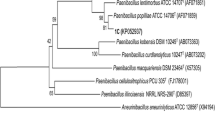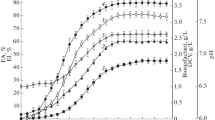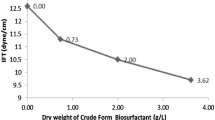Abstract
A biosurfactant-producing bacterium, isolate 2/3, was isolated from mangrove sediment in the south of Thailand. It was evaluated as a potential biosurfactant producer. The highest biosurfactant production (4.52 g/l) was obtained when the cells were grown on a minimal salt medium containing 25 % (v/v) palm oil decanter cake and 1 % (w/v) commercial monosodium glutamate as carbon and nitrogen sources, respectively. After microbial cultivation at 30 °C in an optimized medium for 96 h, the biosurfactant produced was found to reduce the surface tension of pure water to 25.0 mN/m with critical micelle concentrations of 8.0 mg/l. The stability of the biosurfactant at different salinities, pH and temperature and also its emulsifying activity was investigated. It is an effective surfactant at very low concentrations over a wide range of temperatures, pH and salt concentrations. The biosurfactant obtained was confirmed as a glycolipid type biosurfactant by using a biochemical test, fourier-transform infrared spectroscopy, MNR and mass spectrometry. The crude biosurfactant showed a broad spectrum of antimicrobial activity and also had the ability to emulsify oil and enhance polyaromatic hydrocarbons solubility.





Similar content being viewed by others
References
Abbasi H, Hamedi MM, Lotfabad TB, Zahiri HS, Sharafi H, Masoomi F, Moosavi-Movahedi AA, Ortiz A, Amanlou M, Noghabi KA (2012) Biosurfactant-producing bacterium, Pseudomonas aeruginosa MA01 isolated from spoiled apples: physicochemical and structural characteristics of isolated biosurfactant. J Biosci Bioeng 113:211–219
Abdel-Mawgoud AM, Lepine F, Deziel E (2010) Rhamnolipids: diversity of structures, microbial origins and roles. Appl Microbiol Biotechnol 86:1323–1336
Abubakr AR, Alimon AR, Yaakub H, Abdullah N, Ivan M (2013) Growth, nitrogen metabolism and carcass composition of goats fed palm oil by-products. Small Rumin Res 112:91–96
Assadi MM, Tabatabaee MS (2010) Biosurfactants and their use in upgrading petroleum vacuum distillation residue: a review. Int J Environ Res 4:549–572
Banat IM, Franzetti A, Gandolfi I, Bestetti G, Martinotti MG, Fracchia L, Smyth TJ, Marchant R (2010) Microbial biosurfactants production, applications and future potential. Appl Microbiol Biotechnol 87:427–444
Barber WP, Stuckey DC (2000) Nitrogen removal in a modified anaerobic baffled reactor (ABR): 1, denitrification. Water Res 10:2413–2422
Barkay T, Navon-Venezia S, Ron EZ, Rosenberg E (1999) Enhancement of solubilization and biodegradation of polyaromatic hydrocarbons by the bioemulsifier alasan. Appl Environ Microbiol 65:2697–2702
Chavalparit O, Rulkens WH, Mol APJ, Khaodhair S (2006) Options for environmental sustainability of the crude palm oil industry in Thailand through enhancement of industrial ecosystems. Environ Dev Sustain 8:271–287
Cooper DG, Goldenberg BG (1987) Surface-active agents from two Bacillus species. Appl Environ Microbiol 53:224–229
Costa SGVAO, Nitschke M, Lepine F, Deziel E, Contiero J (2010) Structure, properties and applications of rhamnolipids produced by Pseudomonas aeruginosa L2-1 from cassava wastewater. Process Biochem 45:151–1516
Das P, Mukherjee S, Sen R (2009) Biosurfactant of marine origin exhibiting heavy metal remediation properties. Bioresour Technol 100:4887–4890
de Lima CJB, Ribeiro EJ, Servulo EFC, Resende MM, Cardoso VL (2009) Biosurfactant production by Pseudomonas aeruginosa grown in residual soybean oil. Appl Biochem Biotechnol 152:156–168
Dubois M, Gilles KA, Hamilton JK, Rebers PA, Smith F (1956) Colorimetric method for determination of sugars and related substances. Anal Chem 28:350–356
Folch JM, Lees M, Stanly HS (1956) A simple method for the isolation and quantification of total lipids from animal tissues. J Biol Chem 226:497–509
Fracchia L, Cavallo M, Martinotti MG, Banat IM (2012) Chap. 14. In: Ghista DN (ed) Biosurfactants and bioemulsifiers biomedical and related applications-present status and future potentials, biomedical science, engineering and technology, ISBN: 978-953-307-471-9, InTech pp 325–370
Gudina EJ, Rocha V, Teixeira JA, Rodrigues LR (2010) Antimicrobial and antiadhesive properties of a biosurfactant isolated from Lactobacillus paracasei ssp paracasei A20. Lett Appl Microbiol 50:419–424
Haron K, Mohammed AT, Halim RM, Din AK (2008) Palm-based bio-fertilizer from decanter cake and boiler ash of palm oil mill. Malaysian Palm Oil Board (MPOB). Information Series (MPOB TT No. 412):1-4
Intergovernmental Oceanographic Commission Manuals and Guide No.13 (1982). Manual for monitoring oil and dissolved/dispersed petroleum hydrocarbons in marine waters and beaches. UNESCO, Tokyo, Japan
Kim J, Vipulanandan C (2006) Removal of lead from contaminated water and clay soil using a biosurfactant. J Env Engg 132:777–786
Levinson MI (2009) Present realities and future perspectives. In: Zoller U, Sosis P (eds) Handbook of detergents:production. Taylor and Francis, New York, pp 1–37
Lowry OH, Rosebrough NJ, Farr AL, Randall RJ (1951) Protein measurement with the Folin phenol reagent. J Biol Chem 193:265–275
Makkar RS, Rockne KL (2003) Comparison of synthetic surfactants and biosurfactants in enhancing biodegradation of polycyclic aromatic hydrocarbons. Environ Toxicol Chem 22:2280–2292
Maneerat S (2009) Biosurfactants from marine microorganisms. Songklanakarin J Sci Technol 27:1263–1272
Miller RM, Bartha R (1989) Evidence from liposome encapsulation for transport-limited microbial metabolism of solid alkanes. Appl Environ Microbiol 55:269–274
Mulligan CN, Yong CN, Gibbs BF (2001) Heavy metal removal from sediments by biosurfactants. J Hazard Mater 85:111–125
Nawawi WMFW, Jamal P, Alam MZ (2010) Utilization of sludge palm oil as a novel substrate for biosurfactant production. Bioresour Technol 101:9241–9247
Pacwa-Plociniczak M, Plaza GA, Piotrowska-Seget Z, Cameotra SS (2011) Environmental applications of biosurfactants: recent advances. Int J Mol Sci 12:633–654
Praveesh BV, Soniyamby AR, Mariappan C, Kavithakumari P, Palaniswamy M, Lalitha S (2011) Biosurfactant production by Pseudomonas sp. from soil using whey as carbon source. N Y Sci J 4:99–103
Prieto LM, Michelon M, Burkert JFM, Kalil SJ, Burkert CAV (2008) The production of rhamnolipid by a Pseudomonas aeruginosa strain isolated from a southern coastal zone in Brazil. Chemosphere 71:1781–1785
Ramani K, Jain CS, Mandal AB, Sekaran G (2012) Microbial induced lipoprotein biosurfactant from slaughterhouse lipid waste and its application to the removal of metal ions from aqueous solution. Colloid Surf B 97:254–263
Reis FASL, Servulo FC, de Franc FA (2004) Lipopeptide surfactant production by Bacillus subtilis grown on low-cost raw materials. Appl Biochem Biotechnol 113–116:899–912
Rodrigues L, Teixeira J, Oliveira R, Mei HCV (2006) Response surface optimization of the medium components for the production of biosurfactants by probiotic bacteria. Process Biochem 41:1–10
Saimmai A, Sobhon V, Maneerat S (2011) Molasses a whole medium for bosurfactants production by Bacillus strains and their application. Appl Biochem Biotech 165:315–335
Saimmai A, Rukadee O, Onlamool T, Sobhon V, Maneerat S (2012a) An efficient biosurfactant-producing bacterium Selenomonas ruminantium CT2, isolated from mangrove sediment in south of Thailand. World J Microbiol Biotechnol 29:87–102
Saimmai A, Rukadee O, Onlamool T, Sobhon V, Maneerat S (2012b) Isolation and functional characterization of a biosurfactant produced by a new and promising strain of Oleomonas sagaranensis AT18. World J Microbiol Biotechnol 28:2973–2986
Saimmai A, Sobhon V, Maneerat S (2012c) Production of biosurfactant from a new and promising strain of Leucobacter komagatae 183. Ann Microbiol 62:391–402
Saimmai A, Sobhon V, Rukadee O, Maneerat S (2012d) Comparison of biosurfactants produced by Bacillus subtilis TD4 and Pseudomonas aeruginosa SU7 for microbial surfactant-enhanced oil recovery. J Sci Ind Res 71:396–406
Saimmai A, Tani A, Sobhon V, Maneerat S (2012e) Mangrove sediment, a new source of potential biosurfactant producing bacteria. Ann Microbiol 62:1669–1679
Saimmai A, Kaewrueng J, Maneerat S (2012f) Used lubricating oil degradation and biosurfactant production by SC-9 consortia obtained from oil contaminated soil. Ann Microbiol 62:1757–1767
Saimmai A, Rukadee O, Onlamool T, Sobhon V, Maneerat S (2013) Characterization and phylogenetic analysis of microbial surface active compounds-producing bacteria. Appl Biochem Biotechnol 168:1003–1018
Sanchez M, Aranda FJ, Espuny MJ, Marques A, Teruel JA, Manresa A, Ortiz A (2007) Aggregation behavior of a dirhamnolipid biosurfactant secreted by Pseudomonas aeruginosa in aqueous media. J Colloid Interface Sci 307:246–253
Shavandi M, Mohebali G, Haddadi A, Shakarami H, Nuhi A (2011) Emulsification potential of a newly isolated biosurfactant-producing bacterium, Rhodococcus sp. strain TA6. Colloids Surf B 82:4774–4782
Suwansukho P, Rukachisirikul V, Kawai F, Kittikun AH (2008) Production and applications of biosurfactant from Bacillus subtilis MUV4. Songklanakarin J Sci Technol 30:87–93
Tran HG, Desmet T, Saerens K, Waegeman H, Vandekerckhove S, D’hooghe M, Bogaert IV, Soetaert W (2012) Biocatalytic production of novel glycolipids with cellodextrin phosphorylase. Bioresour Technol 115:84–87
Wu JY, Yeh KL, Lu WB, Lin CL, Chang JS (2008) Rhamnolipid production with indigenous Pseudomonas aeruginosa EM1 isolated from oil-contaminated site. Bioresour Technol 99:1157–1164
Acknowledgments
We are grateful to Phuket Rajabhat University for providing a scholarship to AS. This work was supported by the Office of the Higher Education Commission (Thailand) and International Fundation for Science (Sweden) No. F/5204-1.
Author information
Authors and Affiliations
Corresponding author
Rights and permissions
About this article
Cite this article
Noparat, P., Maneerat, S. & Saimmai, A. Utilization of palm oil decanter cake as a novel substrate for biosurfactant production from a new and promising strain of Ochrobactrum anthropi 2/3. World J Microbiol Biotechnol 30, 865–877 (2014). https://doi.org/10.1007/s11274-013-1493-z
Received:
Accepted:
Published:
Issue Date:
DOI: https://doi.org/10.1007/s11274-013-1493-z




